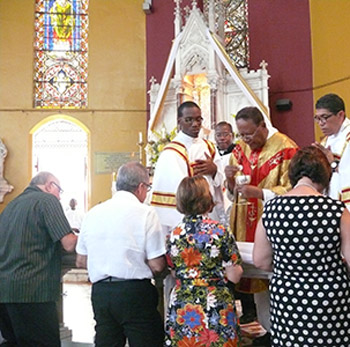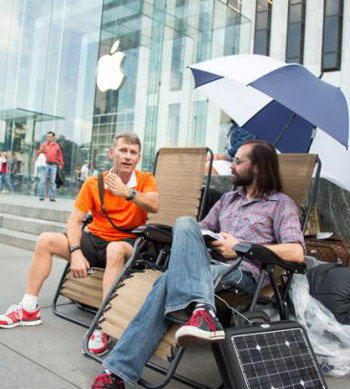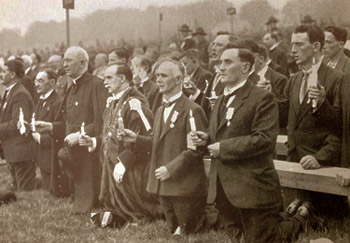Manners, Customs, Clothing
 |
 |
 |
 |
 |
 |
 |
The History of the Tie - IV
Liberalism & Other Thoughts on the Necktie
When we propose the use of the necktie to some traditionalists, the most significant objection we receive is this: “There is no such thing as the Revolution. Vatican II is the real problem, so as long as we have the Tridentine Mass, nothing else really matters. I can dress however I want.”
 As we saw in earlier articles of this series, there is, in fact, a Revolution, of which Vatican II was a logical consequence. One needs only make a brief survey of history to see its presence. For further information, I recommend reading Mr. Guimarães’ concise summary on the topic.
As we saw in earlier articles of this series, there is, in fact, a Revolution, of which Vatican II was a logical consequence. One needs only make a brief survey of history to see its presence. For further information, I recommend reading Mr. Guimarães’ concise summary on the topic.
Those who pretend that there is no Revolution indirectly become its agents. Indeed, when a city is under siege, those who pretend the enemy does not exist unconsciously assist it, allowing the enemy to overcome the city.
The result is that the Revolution takes these unsuspecting souls and turns them into revolutionary puppets to destroy the Church and society through the tendential principles of egalitarian and casual clothing.
Liberalism in clothing is revolutionary
It would be a type of extreme and public cognitive dissonance to be counter-revolutionary in church, but revolutionary everywhere else. One cannot be traditionalist in worship and liberal in everything else.
 To do so would be a form of practical liberalism, which prepared the way for the triumph of Tribalism in today's institutions and customs. Liberalism was wholly condemned by Pius IX in the Syllabus of Errors. Later, in his work Liberalism Is A Sin, Fr. Felix Sarda y Salvany called it “the root of heresy” and “the evil of all evils” (chap. 4). Liberalism’s final goal is the perdition of the souls.
To do so would be a form of practical liberalism, which prepared the way for the triumph of Tribalism in today's institutions and customs. Liberalism was wholly condemned by Pius IX in the Syllabus of Errors. Later, in his work Liberalism Is A Sin, Fr. Felix Sarda y Salvany called it “the root of heresy” and “the evil of all evils” (chap. 4). Liberalism’s final goal is the perdition of the souls.
Why is the position that one can dress however he wants in daily life a tributary of liberalism?
First, it is because to “dress however one wants” makes man the ultimate authority on thought and behavior, rather than Catholic Civilization, the Church and God. This attitude is inspired by pride and sensuality, the two basic driving forces of Liberalism, rather than love of God and neighbor.
Second, it is practical liberalism because although one does not directly and openly state that man should be free to think and act how he wants, he inevitably puts this position into action through the acceptance of egalitarian and casual clothing. This ultimately leads to practical atheism, which is, as Fr. Sarda y Salvany put it, to act and live “without the denial of the existence of God, but yet as if He did not really exist.” (Liberalism is a Sin, chap. 9)
Neutrality and R-CR

 Next, it is important to note that in the fight against the Revolution, one cannot be lukewarm. Dr. Plinio stated it well: “There are no neutrals in the face of the Revolution and the Counter-Revolution.”
Next, it is important to note that in the fight against the Revolution, one cannot be lukewarm. Dr. Plinio stated it well: “There are no neutrals in the face of the Revolution and the Counter-Revolution.”
This especially applies to the semi-counter-revolutionaries (mentioned in my previous article), who argue endlessly that clothing does not matter as long as we go to the Tridentine Mass and live a devout life. As mentioned earlier, they are unknowing puppets for the Revolution, and continue to destroy the Church and society from within through their revolutionary tendencies in clothing.
Thus, to effectively fight the Revolution, a coherent approach is necessary; one must entirely embrace the Counter-Revolution, and to dress well is a step that is necessary. A true counter-revolutionary does not make concessions in clothing, but fully embraces hierarchy and sacrality in all areas of life, especially when he is in public. In terms of men’s clothing, this means wearing a suit and tie.
CR & Catholicism
Last, one might ask: “Sure, I would like to be counter-revolutionary by wearing a necktie (with the proper accoutrements), but what does the Counter-Revolution have anything to do with Catholicism?”
To be a counter-revolutionary is to be authentically Catholic. Dr. Plinio’s words on this matter suffice: “If the Counter-Revolution is the struggle to extinguish the Revolution and to build the new Christendom, resplendent with faith, humble with hierarchical spirit, and spotless in purity, clearly this will be achieved, above all, by a profound action in the hearts of men.
"This action is proper to the Church, which teaches Catholic doctrine and leads men to love and practice it. Therefore, the Church is the very soul of the Counter-Revolution.”
As newcomers to the Counter-Revolution, we need not immediately have recourse to great or lofty means to be its faithful soldiers. We must first start with what is available to us, and this is our clothing.
By wearing a necktie with the appropriate garb in the public sphere, men assume the principles of hierarchy and sacrality inherent in Catholic society and, thus, in a small way, “deal the Revolution the harshest of blows”.
Only then can we truly begin to restore the Church and society to its rightful splendor.
Continued


Sloppy older people giving bad example to the congregation on how to dress for Mass
Those who pretend that there is no Revolution indirectly become its agents. Indeed, when a city is under siege, those who pretend the enemy does not exist unconsciously assist it, allowing the enemy to overcome the city.
The result is that the Revolution takes these unsuspecting souls and turns them into revolutionary puppets to destroy the Church and society through the tendential principles of egalitarian and casual clothing.
Liberalism in clothing is revolutionary
It would be a type of extreme and public cognitive dissonance to be counter-revolutionary in church, but revolutionary everywhere else. One cannot be traditionalist in worship and liberal in everything else.

Dressing ‘however I want’ ends in this kind of public display
Why is the position that one can dress however he wants in daily life a tributary of liberalism?
First, it is because to “dress however one wants” makes man the ultimate authority on thought and behavior, rather than Catholic Civilization, the Church and God. This attitude is inspired by pride and sensuality, the two basic driving forces of Liberalism, rather than love of God and neighbor.
Second, it is practical liberalism because although one does not directly and openly state that man should be free to think and act how he wants, he inevitably puts this position into action through the acceptance of egalitarian and casual clothing. This ultimately leads to practical atheism, which is, as Fr. Sarda y Salvany put it, to act and live “without the denial of the existence of God, but yet as if He did not really exist.” (Liberalism is a Sin, chap. 9)
Neutrality and R-CR

The enormous fall in manners and clothing from the 1932 Irish Eucharistic Congress, above, to the 2015 Eucharistic Congress in Knock, below

This especially applies to the semi-counter-revolutionaries (mentioned in my previous article), who argue endlessly that clothing does not matter as long as we go to the Tridentine Mass and live a devout life. As mentioned earlier, they are unknowing puppets for the Revolution, and continue to destroy the Church and society from within through their revolutionary tendencies in clothing.
Thus, to effectively fight the Revolution, a coherent approach is necessary; one must entirely embrace the Counter-Revolution, and to dress well is a step that is necessary. A true counter-revolutionary does not make concessions in clothing, but fully embraces hierarchy and sacrality in all areas of life, especially when he is in public. In terms of men’s clothing, this means wearing a suit and tie.
CR & Catholicism
Last, one might ask: “Sure, I would like to be counter-revolutionary by wearing a necktie (with the proper accoutrements), but what does the Counter-Revolution have anything to do with Catholicism?”
To be a counter-revolutionary is to be authentically Catholic. Dr. Plinio’s words on this matter suffice: “If the Counter-Revolution is the struggle to extinguish the Revolution and to build the new Christendom, resplendent with faith, humble with hierarchical spirit, and spotless in purity, clearly this will be achieved, above all, by a profound action in the hearts of men.
"This action is proper to the Church, which teaches Catholic doctrine and leads men to love and practice it. Therefore, the Church is the very soul of the Counter-Revolution.”
As newcomers to the Counter-Revolution, we need not immediately have recourse to great or lofty means to be its faithful soldiers. We must first start with what is available to us, and this is our clothing.
By wearing a necktie with the appropriate garb in the public sphere, men assume the principles of hierarchy and sacrality inherent in Catholic society and, thus, in a small way, “deal the Revolution the harshest of blows”.
Only then can we truly begin to restore the Church and society to its rightful splendor.
Continued

Posted December 18, 2017
______________________
______________________








